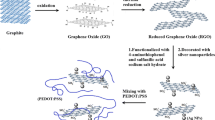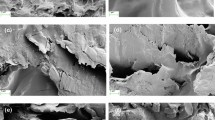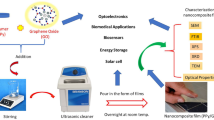Abstract
Hybrid composites have been prepared by solution processing method using various MWCNT concentrations in reduced graphene oxide/poly(3,4-ethylenedioxythiophene) polystyrene sulfonate (rGO-PEDOT:PSS) matrix. Structural and morphological characteristics of the prepared composite films have been characterized by X-ray diffraction, scanning electron microscopy, field emission scanning electron microscopy, Raman spectroscopy, UV–visible spectroscopy and Fourier transform infrared spectroscopy. The electrical transport measurement of composites conducted by four-point contacts shows increase in conductivity with MWCNT wt% in the composite system. The enhanced electrical conductivity as a result of improved dispersion of MWCNTs and rGO has been observed barely affecting the optical properties in the visible region. The observed improvement in electrical properties barely affecting its optical properties in the visible region can be attributed to synergistic effect of MWCNTs and rGO networks on the composite. This result suggests that such hybrid composite materials could be used as transparent conductor applications in optoelectronic devices.










Similar content being viewed by others
References
Malliaras G, Friend R (2005) An organic electronics primer. Phys Today 58:53–58
Mengistie DA, Wangc P-C, Chu C-W (2013) Effect of molecular weight of additives on the conductivity of PEDOT:PSS and efficiency for ITO-free organic solar cells. J Mater Chem A 1:9907–9915
Bernards DA, Malliaras GG (2007) Steady-state and transient behavior of organic electrochemical transistors. Adv Funct Mater 17:3538–3544
Kim N, Kee S, Lee SH, Lee BH, Kahng YH, Jo Y-R, Kim B-J, Lee K (2014) Highly conductive PEDOT:PSS nanofibrils induced by solution-processed crystallization. Adv Mater 26:2268–2272
Wang J, Sun L, Mpoukouvalas K, Lienkamp K, Lieberwirth I, Fassbender B, Bonaccurso E, Brunklaus G, Muehlebach A, Beierlein T, Tilch R, Butt H-J, Wegner G (2009) Construction of redispersible polypyrrole core–shell nanoparticles for application in polymer electronics. Adv Mater 21:1137–1141
Wang P-C, Liu L-H, Mengistie DA, Li K-H, Wend B-J, Liu T-S, Chu C-W (2013) Transparent electrodes based on conducting polymers for display applications. Displays 34:301–314
Cairns DR, Witte RP, Sparacin DK, Sachsman SM, Paine DC, Crawford GP, Newton RR (2000) Strain-dependent electrical resistance of tin-doped indium oxide on polymer substrates. Appl Phys Lett 76:1425–1427
Bouten PCP, Slikkerveer PJ, Leterrier Y (2005) Mechanics of ITO on plastic substrates for flexible displays. In: Crawford GP (ed) Flexible flat panel displays. Wiley, New York, pp 99–120
Groenendaal L, Jonas F, Freitag D, Pielartzik H, Reynolds JR (2000) Poly(3,4-ethylenedioxythiophene) and its derivatives: past, present, and future. Adv Mater 12:481–494
Aasmundtveit KE, Samuelsen EJ, Inganäs O, Pettersson LAA, Johansson T, Ferrer S (2000) Structural aspects of electrochemical doping and dedoping of poly(3,4-ethylenedioxy-thiophene). Synth Met 113:93–97
Xia Y, Sun K, Ouyang J (2012) Highly conductive poly(3,4-ethylenedioxythiophene): poly(styrene sulfonate) films treated with an amphiphilic fluoro compound as the transparent electrode, of polymer solar cells. Energy Environ Sci 5:5325–5332
Alemu D, Wei Hung-Yu, Ho K-C, Chu C-W (2012) Highly conductive PEDOT:PSS electrode by simple film treatment with methanol for ITO-free polymer solar cells. Energy Environ Sci 5:9662–9671
Hatton RA, Blanchard NP, Tan LW, Latini G, Cacialli F, Ravi S, Silva P (2009) Oxidised carbon nanotubes as solution processable, high work function hole-extraction layers for organic solar cells. Org Electron 10:388–395
Wang X, Li Q, Xie J, Jin Z, Wang J, Li Y, Jiang K, Fan S (2009) Fabrication of ultralong and electrically uniform single-walled carbon nanotubes on clean substrates. Nano Lett 9(9):3137–3141
Ebbesen TW, Lezec HJ, Hiura H, Bennett JW, Ghaemi HF, Thio T (1996) Electrical conductivity of individual carbon nanotubes. Nature 382:54–56
Kim P, Shi L, Majumdar A, McEuen PL (2001) Thermal transport measurements of individual multiwalled nanotubes. Phys Rev Lett 87:215502/215501–215502/215504
Yakobson BI, Brabec CJ, Bernholc J (1996) Nanomechanics of carbon tubes: instabilities beyond linear response. Phys Rev Lett 76:2511–2514
Overney G, Zhong W, Tomanek D (1993) Z., Structural rigidity and low frequency vibrational modes of long carbon tubules. Phys D 27:93–96
Monirul Islam M, Aboutalebi SH, Cardillo D, Liu HK, Konstantinov K, Dou SX (2015) Self-assembled multifunctional hybrids: toward developing high-performance graphene-based architectures for energy storage devices. ACS Cent Sci 1(4):206–216
Wimalasiri Y, Zou L (2013) Carbon nanotube/graphene composite for enhanced capacitive deionization performance. Carbon 59:464–471
Yana J, Wei T, Fana Z, Qian W, Zhang M, Shena X, Wei F (2010) Preparation of graphene nanosheet/carbon nanotube/polyaniline composite as electrode material for supercapacitors. J Power Sources 195:3041–3045
Cheng Q, Tang J, Shinya N, Qin L-C (2013) Polyaniline modified graphene and carbon nanotube composite electrode for asymmetric supercapacitors of high energy density. J Power Sources 241:423–428
Li F, Cai K, Shen S, Chen S (2014) Preparation and thermoelectric properties of reduced graphene oxide/PEDOT:PSS composite films. Synth Met 197:58–61
Wang G-F, Tao X-M, Wang R-X (2008) Fabrication and characterization of OLEDs using PEDOT:PSS and MWCNT nanocomposites. Compos Sci Technol 68:2837–2841
Seekaew Y, Lokavee S, Phokharatkul D, Wisitsoraat A, Kerdcharoen T, Wongchoosuk C (2014) Low-cost and flexible printed graphene–PEDOT:PSS gas sensor for ammonia detection. Org Electron 15:2971–2981
Yang W, Zhao Y, He X, Chen Y, Jianhua X, Li S, Yang Y, Jiang Y (2015) Flexible conducting polymer/reduced graphene oxide films: synthesis, characterization, and electrochemical performance. Nanoscale Res Lett 10:222
Patole AS, Patole SP, Jung S-Y, Yoo J-B, An J-H, Kim T-H (2012) Self assembled graphene/carbon nanotube/polystyrene hybrid nanocomposite by in situ microemulsion polymerization. Eur Polym J 48:252–259
Zhao Q, Jamal R, Zhang L, Wang M, Abdiryim T (2014) The structure and properties of PEDOT synthesized by template-free solution method. Nanoscale Res Lett 9:557
Mahanandia P, Nanda KK (2008) A one-step technique to prepare aligned arrays of carbon nanotubes. Nanotechnology 19:155602–155608
Mahanandia P, Vishwakarma PN, Nanda KK, Prasad V, Barai K, Mondal AK, Sarangi S, Dey GK, Subramanyam SV (2008) Synthesis of multi-wall carbon nanotubes by simple pyrolysis. Solid State Commun 145:143–148
Hummers W, Offeman R (1958) Preparation of graphitic oxide. J Am Chem Soc 80:1339
Wang Z, Ba D, Liu F, Cao P, Yang T, Yousong G, Gao H (2005) Synthesis and characterization of large area well-aligned carbon nanotubes by ECR–CVD without substrate bias. Vacuum 77:139–144
Yang W-CM-H, Jong S-B, Lin P-C, Yuan S-S, Chi-Yu L, Chiang P-W, Chung T-W, Tsai W-C, Tyan Y-C (2014) Characterization of silk fibroin modified surface: a proteomic view of cellular response proteins induced by biomaterials. BioMed Res Int 2014:209469
Ionescu R, Espinosa EH, Sotter E, Llobet E, Vilanova X, Correig X, Felten A, Bittencourt C, Van Lier G, Charlier J-C, Pireaux JJ (2006) Oxygen functionalisation of MWNT and their use as gas sensitive thick-film layers. Sens Actuators, B 113:36–46
Li H, Sun M, Zhang T, Fang Y, Wang G (2014) Improving the performance of PEDOT–PSS coated sulfur@activated porous graphene composite cathodes for lithium–sulfur batteries. J Mater Chem A 2:18345–18352
Yoo D, Kim J, Kim JH (2014) Direct synthesis of highly conductive poly(3,4-Ethylenedioxythiophene):poly(4-styrenesulfonate) (PEDOT:PSS)/graphene composites and their applications in energy harvesting systems. Nano Res 7(5):717–730
Costa S, Borowiak-Palen E, Kruszyńska M, Bachmatiuk A, Kaleńczuk RJ (2008) Characterization of carbon nanotubes by Raman spectroscopy. Mater Sci Pol 26(2):433–441
Lehman JH, Terrones M, Mansfield E, Hurst KE, Meunier V (2011) Evaluating the characteristics of multiwall carbon Nanotubes. Carbon 49:2581–2602
Wakizaka D, Fushimi T, Ohkita H, Ito S (2004) Hole transport in conducting ultrathin films of PEDOT/PSS prepared by layer-by-layer deposition technique. Polymer 45:8561–8565
Snaith HJ, Kenrick H, Chiesa M, Friend RH (2005) Morphological and electronic consequences of modifications to the polymer anode ‘PEDOT:PSS’. Polymer 46:2573–2578
Yang S-Y, Lin W-N, Huang Y-L, Tien H-W, Wang Jeng-Yu, Ma C-CM, Li S-M, Wang Y-S (2011) Synergetic effects of graphene platelets and carbon nanotubes on the mechanical and thermal properties of epoxy composites. Carbon 49:793–803
Liu M, Johnston MB, Snaith HJ (2013) Efficient planar heterojunction perovskite solar cells by vapour deposition. Nature 501:395–398
Liang P-W, Liao C-Y, Chueh C-C, Spencer FZ, Williams T, Xin X-K, Lin J, Jen AK-Y (2014) Additive enhanced crystallization of solution-processed perovskite for highly efficient planar-heterojunction solar cells. Adv Mater 26:3748–3754
Kojima A, Teshima K, Shirai Y, Miyasaka T (2009) Organometal halide perovskites as visible-light sensitizers for photovoltaic cells. J Am Chem Soc 131:6050–6051
Dubin S, Gilje S, Wang K, Tung VC, Cha K, Hall AS, Farrar J, Varshneya R, Yang Y, Kaner RB, One-Step A (2010) Solvothermal reduction method for producing reduced graphene oxide dispersions in organic solvents. ACS Nano 4:3845–3852
Wu Y, Wang B, Ma Y, Huang Y, Li N, Zhang F, Chen Y (2010) Efficient and large-scale synthesis of few-layered graphene using an arc-discharge method and conductivity studies of the resulting films. Nano Res 3:661–669
Kim J, You J, Kim E (2010) Flexible conductive polymer patterns from vapor polymerizable and photo-cross-linkable EDOT. Macromolecules 43:2322–2327
Si Y, Samulski ET (2008) Synthesis of water soluble graphene. Nano Lett 8(6):1679–1682
Kvarnström C, Neugebauer H, Blomquist S, Ahonen HJ, Kankare J, Ivaska A (1999) In situ spectroelectrochemical characterization of poly(3,4-ethylenedioxythiophene). Electrochim Acta 44:2739–2750
Chen T, Qiu J, Zhu K, Li J, Wang J, Li S, Wang X (2014) Ultra high permittivity and significantly enhanced electric field induced strain in PEDOT:PSS–RGO@PU intelligent shape-changing electro-active polymers. RSC Adv 4:64061–64067
Taggart DK, Yang Y, Kung S-C, McIntire TM, Penner RM (2011) Enhanced thermoelectric metrics in ultra-long electrodeposited PEDOT nanowires. Nano Lett 11(1):125–131
Lee J, Choi W (2015) Surface modification of sulfur cathodes with PEDOT:PSS conducting polymer in lithium-sulfur batteries. J Electrochem Soc 162(6):A935–A939
Wang XJ, Wong KY (2006) Effects of a base coating used for electro-polymerization of poly(3,4-ethylenedioxythiophene) on indium tin oxide electrode. Thin Solid Films 515:1573–1578
Lee Y, Ahn J-H (2013) Graphene-based transparent conductive films. NANO Brief Rep Rev 8(3):1330001
Guan G, Yang Z, Qiu L, Sun X, Zhang Z, Ren J, Peng H (2013) Oriented PEDOT:PSS on aligned carbon nanotubes for efficient dye-sensitized solar cells. J Mater Chem A 1:13268–13273
Kang KS, Lim HK, Cho KY, Han KJ, Kim J (2008) Durability of PEDOT:PSS-pentacene schottky diode. J Phys D Appl Phys 41:012003
Ji T, Tan L, Xiaotian H, Dai Y, Chen Y (2015) A comprehensive study of sulfonated carbon materials as conductive composites for polymer solar cells. Phys Chem Chem Phys 17:4137–4145
Acknowledgement
This work is financially supported by Science and Engineering Research Board, Government of India through Grant Number SB/S2/CMP-109/2013.
Author information
Authors and Affiliations
Corresponding author
Ethics declarations
Conflict of interest
We have no conflict of interest with any author or funding agency.
Electronic supplementary material
Below is the link to the electronic supplementary material.
Rights and permissions
About this article
Cite this article
Mahakul, P.C., Sa, K., Das, B. et al. Preparation and characterization of PEDOT:PSS/reduced graphene oxide–carbon nanotubes hybrid composites for transparent electrode applications. J Mater Sci 52, 5696–5707 (2017). https://doi.org/10.1007/s10853-017-0806-2
Received:
Accepted:
Published:
Issue Date:
DOI: https://doi.org/10.1007/s10853-017-0806-2




